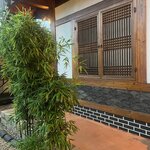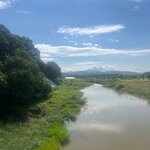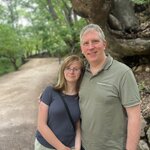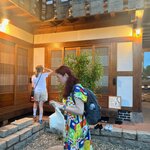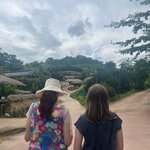Weather
July brings the heat to South Korea, with an average temperature high of 81°F (27°C). The weather remains steamy well into the evenings, rarely dipping below 70°F (21°C). July shares the distinction of the hottest month of the year with August, and visitors can expect temperatures to continue to climb throughout the month. To avoid overheating and dehydration, travelers should come prepared with lightweight clothing and carry a water bottle for daytime excursions.
This month is also the rainiest of the year, averaging 15.5 inches (395 mm) of monthly rainfall in Seoul. In South Korea, the annual monsoon season (jangma) begins in late June and continues throughout July, bringing heavy rain and, more rarely, flooding and typhoons. With an average of only four hours of daily sunshine, an umbrella and rain boots are a must-pack. Even on sunny days, visitors should be mindful of high humidity levels, which can reach up to 90%. The heat and rain make indoor activities especially attractive this month, though beach days are popular when the sun shines.
Crowds & Costs
With South Korean children out of school, family travel picks up. Visitors may experience higher crowds at major tourist attractions across the country. Kid-friendly destinations like South Korea's popular amusement parks will likely be bustling. On sunny days, tourists flock to the beach. Top beach destinations, including Busan, Gangneung, and Jeju Island, can see large crowds of sunbathers this month. The best way to beat the masses (and the heat) is to arrive early in the day for the most favored sights and excursions.
With the increased demand, prices for flights and accommodations are also likely to be higher than usual. Travelers can offset the increased costs by taking advantage of the country's many free and low-cost activities, including parks, museums, and cultural heritage sites.
Chat with a local specialist who can help organize your trip.
Where to Go
The city of Busan on South Korea's southeastern coast tops the list of the country's most prized summertime destinations. With seven public beaches, visitors have no shortage of options for sunbathing, water sports, and strolling along sandy shores. There's more to Busan than its beaches, though. Take an afternoon to explore the colorful hillside village of Gamecheon and Beomeosa, a 1,300-year-old Buddhist temple, before grabbing a bite to eat at one of the city's many street food markets. For a day trip, nearby Geoje Island offers a slower pace of life and the opportunity to enjoy South Korea's natural beauty.
Gangneung, a picturesque coastal city in the northeast, presents an appealing alternative (or addition) for beach lovers. Start your day by watching the sunrise at the aptly named Jeongdonjin Sunrise Park, which draws visitors from across the country for its extraordinary morning views. Then, catch some rays at Gyeongpo Beach, among the most popular in South Korea due to its white sand and clear blue waters. Like Busan, Gangneung has much to offer beyond its beaches. The city has a long history; tourists can visit aristocratic residences dating back to the Joseon dynasty.
What to Do
Hot, sunny weather inevitably beckons locals and tourists to the beach; they'll be crowded this month, so arrive early in the day to stake out a great spot. If you're lucky, your beach day might coincide with one of South Korea's summer festivals, such as the Boryeong Mud Festival at Daechon Beach or the Busan Sea Festival, which spans five beaches across the city.
For families traveling on summer vacation, there are a variety of kid-friendly activities. Travelers to Seoul can visit Lotte World, home to an outdoor amusement park and one of the world's largest indoor theme parks (perfect for rainy July days). Alternatively, drive three hours to Everland, South Korea's largest theme park, for a day trip, which receives more than five million visitors annually. Once you've had your fill of adrenaline-inducing rides, visit the Seoul Children's Museum for an educational outing that will engage the whole family, or take the kids to the COEX Aquarium.
If you're visiting a holiday hot spot like Busan or Jeju Island and find yourself caught in the rain, never fear. Indoor activities abound in South Korea's major cities. In Busan, visit the fresh seafood shops of Jagalchi Market or spend the afternoon exploring the Sea Life Busan Aquarium. On Jeju Island, the Yeomiji Botanical Garden, featuring more than 2,000 tropical and subtropical plants, will keep you entertained until the sun comes out again.
Events in July
Boryeong Mud Festival, Daecheon Beach. Daecheon Beach in Boryeong transforms into a festival honoring the region's mineral-rich mud, including mud wrestling and a giant mudslide in July and August.
Busan Sea Festival, Busan. Spanning five beaches across Busan, this summertime festival at the end of July and beginning of August offers vibrant nightlife, concerts, and dance parties.
Buyeo Seodong Lotus Festival, Buyeo. This festival takes place at the height of the lotus season in July and features fireworks, a multimedia show, and canoeing through stunning lotus fields.
Pohang International Fireworks Festival, Pohang. International fireworks competition with a lively parade, DJ concert, and more.
More Helpful Information
South Korea in June
South Korea in August
Best Time of Year to Visit South Korea
How Many Days to Spend in South Korea

